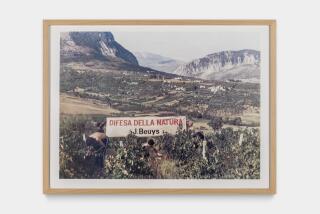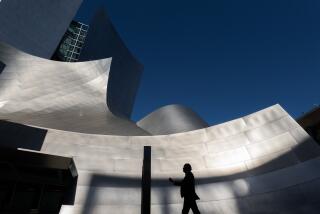A look inside Eli Broad’s museum, which will offer free admission
As construction continues on the downtown Los Angeles museum Eli Broad and his wife, Edythe, have dubbed the Broad, the couple were due to give a look inside in a “hard-hat tour” Tuesday for news media and invited guests. And they had some news.
When the contemporary art museum opens late next year, admission will be free.
Besides stocking the museum with their nearly 2,000-piece collection of art from the 1950s to the present at the museum, the Broads are providing at least $395 million to build and endow it.
The Times had a preliminary look at the Grand Avenue building Monday, guided by Joanne Heyler, the longtime director and chief curator of the Broad Art Foundation, whose new title is founding director of the Broad.
PANORAMA: Inside The Broad under construction
Heyler said that general admission to the permanent collection will be free, although fees will sometimes be charged for admission to galleries featuring special temporary exhibitions.Those prices haven’t been determined.
She said the Broad will be open at least five days a week.
Construction of the Broad began in 2012 and has produced no surprises, according to Heyler and Kevin Rice, senior associate of Diller, Scofidio + Renfo, the New York City architecture firm that designed the museum.
The projected cost has risen from $130 million when the design was announced in January 2011 to $140 million -- an increase Heyler said was manageable.
An additional $55 million is being spent on a 366-space below-ground parking garage and an outdoor plaza south of the museum that will involve laying a paved platform over Kosciuszko Way, which runs past the museum at a lower level. The platform will become the equivalent of a huge, dirt-filled planter that will allow for landscaping features, Rice said.
PHOTOS: Arts and culture in pictures by The Times
The museum doesn’t figure to be changed much from its original design when it’s unveiled next year -- although because the architects have dubbed its honeycomb-like, white-concrete exterior curtain “the veil,” that might not be quite the right term.
The most important difference, Heyler said, has been placing its large, cylindrical passenger elevator near the middle of the museum instead of off in a corner. That means visitors will debark in more or less the same area whether they climb the stairs, take the escalator or the elevator to the 35,000 square foot exhibition hall on the third floor.
There, the ceiling, 23-feet high, has no support columns to diminish the impression of being in a single, vast room. Temporary walls can be installed to divide the space, but they won’t reach to the ceiling.
The ceiling is honeycombed with 318 rectangular indentations, each with an aperture that lets light stream in from the north.
Heyler said the aim is to capture light that’s bright enough to show artworks to their best advantage but not so bright as to damage them or mar the viewing experience with glare.
INTERACTIVE: High-earning conductors | High-earning arts executives
As daylight fades, sensors will cue adjustable track lighting near the ceiling to automatically compensate and maintain the desired brightness. The light apertures can be blocked off above areas featuring photographs and other particularly light-sensitive works.
On the ground floor, visitors will arrive through a glassed-in front to an enclosed lobby that stands outside the building’s core, but below its cantilevered upper floors. The core, dubbed “the vault” by the architects because it encloses the galleries and enough storage space for virtually the entire collection, curves to the ground in an effect evoking giant mushrooms or a hobbit’s house from J.R.R. Tolkien.
Moving straight ahead, museum-goers will come to the 15,000 square-foot ground-floor gallery. With a ceiling 18 feet high, it can also be walled off into separate areas that allow for smaller special exhibitions.
The other option is ascending directly to the third floor, reserved for longer-lasting displays of collection highlights.
The 105-foot-long escalator rises on a diagonal through a tube-like opening. There’s an extra reward, however, in opting for the nearby stairs. At two points, people on foot can pause at landings, stand at a railing and look into a vast storage room where paintings not on display will be hung on giant, wall-like panels. One view is from near ground level, while another is from an elevated overlook. Riders on the elevator and escalator will have quick, passing glimpses of the paintings in storage.
“I’ve joked with Eli that I now will have to curate storage as well as the galleries,” Heyler said. A guide to what’s visible in storage may be available as an application for mobile devices.
The Broad’s opening exhibition will stay up for at least three months and be free, Heyler said. It will feature about 250 works arrayed so that visitors can take a decade-by-decade chronological walk through recent art history as it’s reflected in the Broads’ acquisitions, which include some pieces from the 1950s but focus mainly on the 1960s onward.
Visitors who want the full chronological effect will head to the Broad’s third floor and proceed in order from the 1950s through the 1990s; the 21st century will be at ground level.
The second floor houses offices and a 200-capacity lecture and conference space that’s been named Oculus Hall. That’s in honor of one of the museum’s most distinctive features, a socket-like indentation in its Eastern façade that the architects have dubbed “the oculus,” Latin for eye. It provides a sort of picture window for the conference room.
Heyler said it’s not yet certain which pieces will greet viewers in strategic spots such as the lobby and the third-floor landing.
To coincide with the opening, she said, the Broad will bring out two new publications: a nearly 400-page collection catalog with about 20 essays on featured artists and a book about the building itself.
Heyler said the Broad Art Foundation will continue to lend works from the collection to museums around the world for temporary display -- the essence of its mission since its 1984 founding. However, she acknowledged, once the Broad opens it might be more difficult for others to pry loose some key pieces that audiences will most want to see in L.A.
“We’re looking at all kinds of exhibitions,” Heyler said, including shows that include art lent from other collections. But even those, she said, will be anchored by art that belongs to the Broad.
ALSO:
Milestone for the Broad, an art museum coming to Grand Avenue
Critic’s notebook: Broad museum design pointed in the right direction
Critic’s notebook: Expanded plaza is a new wrinkle in Broad museum plan
More to Read
The biggest entertainment stories
Get our big stories about Hollywood, film, television, music, arts, culture and more right in your inbox as soon as they publish.
You may occasionally receive promotional content from the Los Angeles Times.











